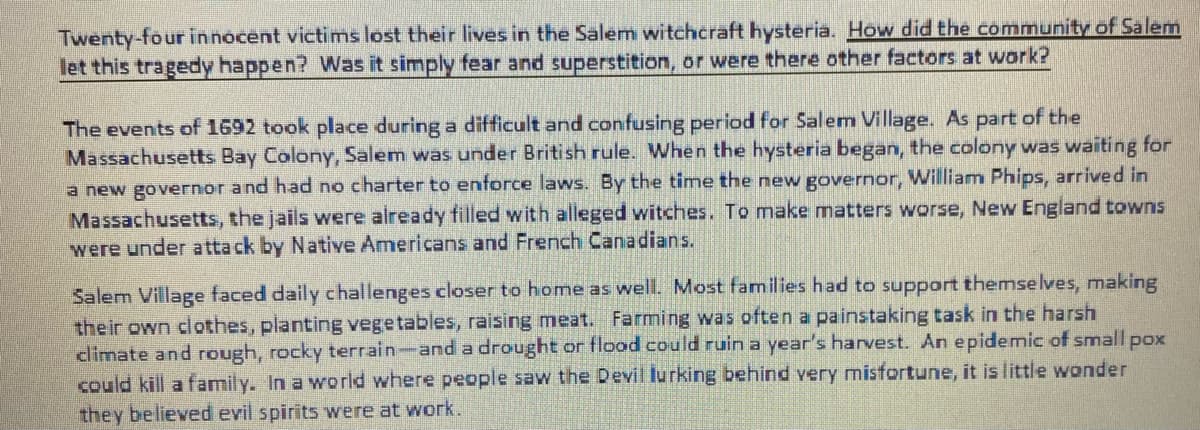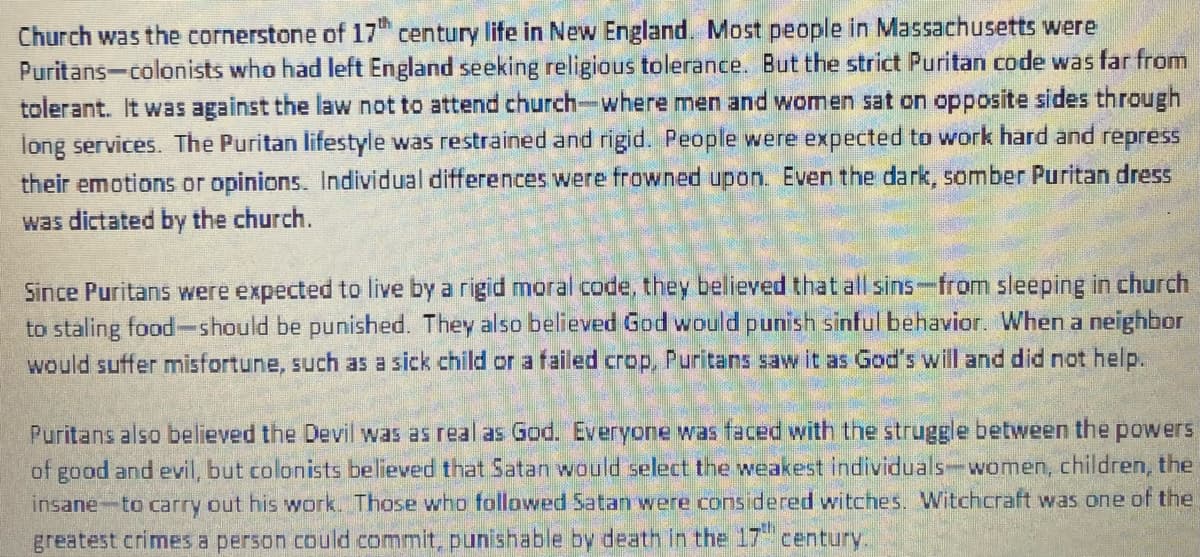All of the following may have contributed to the mass hysteria that led to the Salem Trials except: A. Rivalry between the farming Salem Village and the business oriented Salem Town. B. Strong, trustworthy leaders insisted in the existence of witchcraft. C. The Puritans belief in god was faltering in the New World. D. The people were already on edge from the close proximity of the Native Americans. E. The strange behavior of the girls brought on ergot food poisoning.
All of the following may have contributed to the mass hysteria that led to the Salem Trials except: A. Rivalry between the farming Salem Village and the business oriented Salem Town. B. Strong, trustworthy leaders insisted in the existence of witchcraft. C. The Puritans belief in god was faltering in the New World. D. The people were already on edge from the close proximity of the Native Americans. E. The strange behavior of the girls brought on ergot food poisoning.
Related questions
Question
All of the following may have contributed to the mass hysteria that led to the Salem Trials except: A. Rivalry between the farming Salem Village and the business oriented Salem Town. B. Strong, trustworthy leaders insisted in the existence of witchcraft. C. The Puritans belief in god was faltering in the New World. D. The people were already on edge from the close proximity of the Native Americans. E. The strange behavior of the girls brought on ergot food poisoning.

Transcribed Image Text:Twenty-four innocent victims lost their lives in the Salem witchcraft hysteria. How did the community of Salem
let this tragedy happen? Was it simply fear and superstition, or were there other factors at work?
The events of 1692 took place during a difficult and confusing period for Salem Village. As part of the
Massachusetts Bay Colony, Salem was under British rule. When the hysteria began, the colony was waiting for
a new governor and had no charter to enforce laws. By the time the new governor, William Phips, arrived in
Massachusetts, the jails were already filled with alleged witches. To make matters worse, New England towns
were under attack by Native Americans and French Canadians.
Salem Village faced daily challenges closer to home as well. Most families had to support themselves, making
their own clothes, planting vegetables, raising meat. Farming was often a painstaking task in the harsh
climate and rough, rocky terrain-and a drought or flood could ruin a year's harvest. An epidemic of small pox
could kill a family. In a world where people saw the Devil lurking behind very misfortune, it is little wonder
they believed evil spirits were at work.

Transcribed Image Text:Church was the cornerstone of 17th century life in New England. Most people in Massachusetts were
Puritans-colonists who had left England seeking religious tolerance. But the strict Puritan code was far from
tolerant. It was against the law not to attend church-where men and women sat on opposite sides through
long services. The Puritan lifestyle was restrained and rigid. People were expected to work hard and repress
their emotions or opinions. Individual differences were frowned upon. Even the dark, somber Puritan dress
was dictated by the church.
Since Puritans were expected to live by a rigid moral code, they believed that all sins-from sleeping in church
to staling food-should be punished. They also believed God would punish sinful behavior. When a neighbor
would suffer misfortune, such as a sick child or a failed crop, Puritans saw it as God's will and did not help.
Puritans also believed the Devil was as real as God. Everyone was faced with the struggle between the powers
of good and evil, but colonists believed that Satan would select the weakest individuals women, children, the
insane to carry out his work. Those who followed Satan were considered witches. Witchcraft was one of the
greatest crimes a person could commit, punishable by death in the 17 century.
Expert Solution
This question has been solved!
Explore an expertly crafted, step-by-step solution for a thorough understanding of key concepts.
Step by step
Solved in 2 steps
